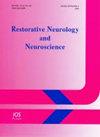Factors Associated With Stroke Mortality in an Urban-Rural Environment: The Case of the MONKOLE Hospital Centre
IF 1.6
4区 医学
Q4 NEUROSCIENCES
引用次数: 0
Abstract
Background: Stroke is a fatal disease, and knowledge of the factors associated with this mortality in different environments is necessary in order to take appropriate action. This article presents data from a hospital located in an urban-rural setting in Kinshasa: The Monkole hospital centre. Methods: This is a cross-sectional study conducted at Monkole hospital Centre from 01/01/2020 to 31/01/2023 in all patients with a confirmed diagnosis of stroke admitted to intensive care, emergency or internal medicine. Sociodemographic, clinical, paraclinical, therapeutic and outcome data were collected from hospital registers and patient records. Student's t, Anova, Chi-squared or Fischer's exact tests and logistic regression were performed with SPSS 25.0 with p less than 5%. Ethical principles were respected. Results: Of 3,629 patients admitted during the study period, 148 (4%) were admitted for stroke. The mean age was 62.6 years and the predominant sex was male. 51.4% of patients were admitted from home, with the following comorbidities: arterial hypertension, diabetes mellitus and embolism-induced heart disease. Frequent reasons for consultation were: disturbed consciousness, increased blood pressure and convulsions. Frequent physical signs were: disturbed consciousness, increased blood pressure, neurological deficit and pupillary abnormalities. The average time to hospital was 13.6 ± 8.2 hours. The accident was ischaemic in 70.3% and haemorrhagic in 29.7%. Treatment was medical in 100% of cases, with no thrombolysis. Mortality was 11.5% and 36.5% of survivors had moderate to severe functional disability. Advanced age (OR 2.34, 95% CI 1.36-4.04), hypertension (OR 2.19, 95% CI 1.24-3.88) and low socio-economic status (OR 1.81, 95% CI 1.02-3.21) were associated with mortality. Conclusion: Mortality in this series was 11.5%, associated with advanced age, hypertension and low socioeconomic status. Controlling blood pressure and improving living conditions could reduce this mortality城乡环境下脑卒中死亡率的相关因素:以MONKOLE医院为例
背景:中风是一种致命疾病,了解不同环境下与这种死亡率相关的因素是必要的,以便采取适当的行动。本文介绍了位于金沙萨城乡环境中的一家医院的数据:Monkole医院中心。方法:这是一项横断面研究,于2020年1月1日至2023年1月31日在Monkole医院中心进行,纳入了所有确诊为中风的重症监护、急诊或内科患者。社会人口学、临床、临床辅助、治疗和结果数据从医院登记和患者记录中收集。采用SPSS 25.0进行学生t、方差分析、χ 2或Fischer精确检验和logistic回归,p < 5%。伦理原则得到尊重。结果:在研究期间入院的3,629例患者中,148例(4%)因中风入院。平均年龄62.6岁,以男性居多。51.4%的患者从家中入院,伴有以下合并症:动脉高血压、糖尿病和栓塞性心脏病。常见的问诊原因是:意识障碍、血压升高和抽搐。常见体征为意识障碍、血压升高、神经功能缺损和瞳孔异常。平均入院时间为13.6±8.2小时。70.3%为缺血性,29.7%为出血。100%的病例采用药物治疗,无溶栓。死亡率为11.5%,36.5%的幸存者有中度至重度功能残疾。高龄(OR 2.34, 95% CI 1.36-4.04)、高血压(OR 2.19, 95% CI 1.24-3.88)和低社会经济地位(OR 1.81, 95% CI 1.02-3.21)与死亡率相关。结论:该病例的死亡率为11.5%,与高龄、高血压和低社会经济地位有关。控制血压和改善生活条件可以降低这种死亡率
本文章由计算机程序翻译,如有差异,请以英文原文为准。
求助全文
约1分钟内获得全文
求助全文
来源期刊
CiteScore
5.40
自引率
3.60%
发文量
22
审稿时长
>12 weeks
期刊介绍:
This interdisciplinary journal publishes papers relating to the plasticity and response of the nervous system to accidental or experimental injuries and their interventions, transplantation, neurodegenerative disorders and experimental strategies to improve regeneration or functional recovery and rehabilitation. Experimental and clinical research papers adopting fresh conceptual approaches are encouraged. The overriding criteria for publication are novelty, significant experimental or clinical relevance and interest to a multidisciplinary audience. Experiments on un-anesthetized animals should conform with the standards for the use of laboratory animals as established by the Institute of Laboratory Animal Resources, US National Academy of Sciences. Experiments in which paralytic agents are used must be justified. Patient identity should be concealed. All manuscripts are sent out for blind peer review to editorial board members or outside reviewers. Restorative Neurology and Neuroscience is a member of Neuroscience Peer Review Consortium.

 求助内容:
求助内容: 应助结果提醒方式:
应助结果提醒方式:


